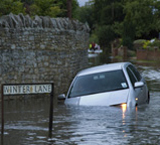 Thursday 29 November 2012 – Congratulations to the 2012 Lloyd’s Science of Risk Prize Awards winners
Thursday 29 November 2012 – Congratulations to the 2012 Lloyd’s Science of Risk Prize Awards winners
There were two categories in this year’s Science of Risk competition on the theme of the “Natural World.” Scientists were asked to submit research on Climate Change and Natural Hazards. The winning reports have far-reaching implications for the analysis and management of flood risk in particular Natural hazard – predicting floods The winner in this category was Professor Paul Bates, Director of the Cabot Institute at the University of Bristol. He is also Professor of Hydrology in the School of Geographical Sciences at Bristol. Professor Bates’ research addresses the problems of time and cost involved in analyzing flood data used to predict the probability and severity of future flooding.
While government agencies, consultants and insurers typically use models to predict flood probability, these tend to be accurate to post-code level – around 50 metres. Such models also tend to be expensive in computing time and therefore cost, often taking days to run thousands of complex flood scenarios covering a chosen geographical area. By developing faster more refined algorithms, Professor Bates has enabled analysis to focus to the level of a single building and the risks to it, as well as carrying out calculations far more quickly and cheaply. “You can view the benefits of our research on a number of levels, ” explains Professor Bates. “There’s a benefit to flood risk analysts because it will enable them to produce more accurate models and save them a great deal of time and money. There is a benefit to insurers in terms of better risk management for insurance and reinsurance companies. The general public will be able to buy the correct amount of flood insurance. Government’s maps will be better, so property purchase decisions can be improved. Finally, if a flood does take place then the emergency services will have better, more accurate tools at their disposal to address the problem.”
Analysts throughout the UK and many places around the world are now using algorithms arising from this research. In the long term, as available data becomes more detailed and more widely sourced, the speed and accuracy with which extreme flood events will be able to be modelled and predicted will be greatly enhanced by this research and at a much lower cost. Climate change – Flooding and cliff erosion The winner was Professor Richard Dawson who is Chair of Earth Systems Engineering at Newcastle University and a co-leader of the Tyndall Centre’s Cities & Coasts theme.
Professor Dawson’s work concerned the analysis of the risks associated with flooding and cliff erosion. This was in the context of threats from rising sea levels and increases in the frequency and intensity of storms, which together comprise the largest potential insurance loss in the UK and globally.
The key to this research is that it takes the analysis of the complexity of flood risk to a new level. “By understanding some of the interconnected processes we start to appreciate that flood protection is not just about building the biggest dyke possible, ” says Dawson. “There are other ways of working more subtly with nature and natural processes rather than trying to tackle nature head on and fighting it with a wall.”
Professor Dawson stresses that the factors that lead to flooding cannot be taken in isolation but interact with each other and the geography that they impact. Together with colleagues from the Tyndall Centre for Climate Change Research, Dawson developed a unique, integrated assessment system that couples simulations of climate change projections, coastal hydrodynamics, coastal morphology, flood defence reliability, inundation and land use change. This system enables a variety of flood scenarios to be compared quantitatively for the first time in terms of changes in expected annual damage.
The research focused on the Happisburgh area of Norfolk in the UK, but it is applicable to any flood risk area in the world. With increasingly rigorous data collection and analysis in particularly high-risk areas, such as those in low-lying and high population coastal centres in emerging markets, Professor Dawson’s work can be expected to enable better management of flood risk, preservation of life and property and limitation of related insurance losses.
(source: Lloyd’s of London website)





